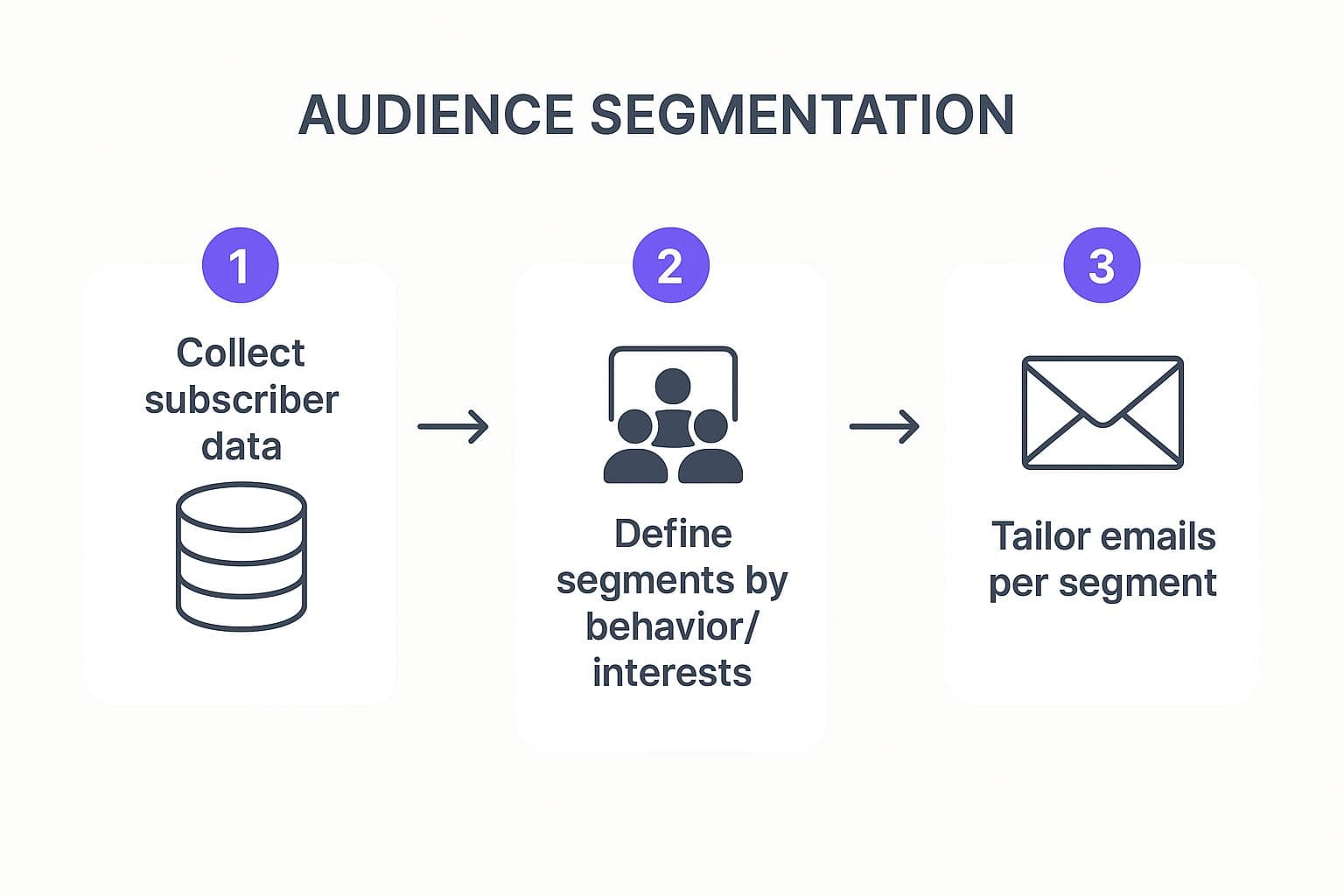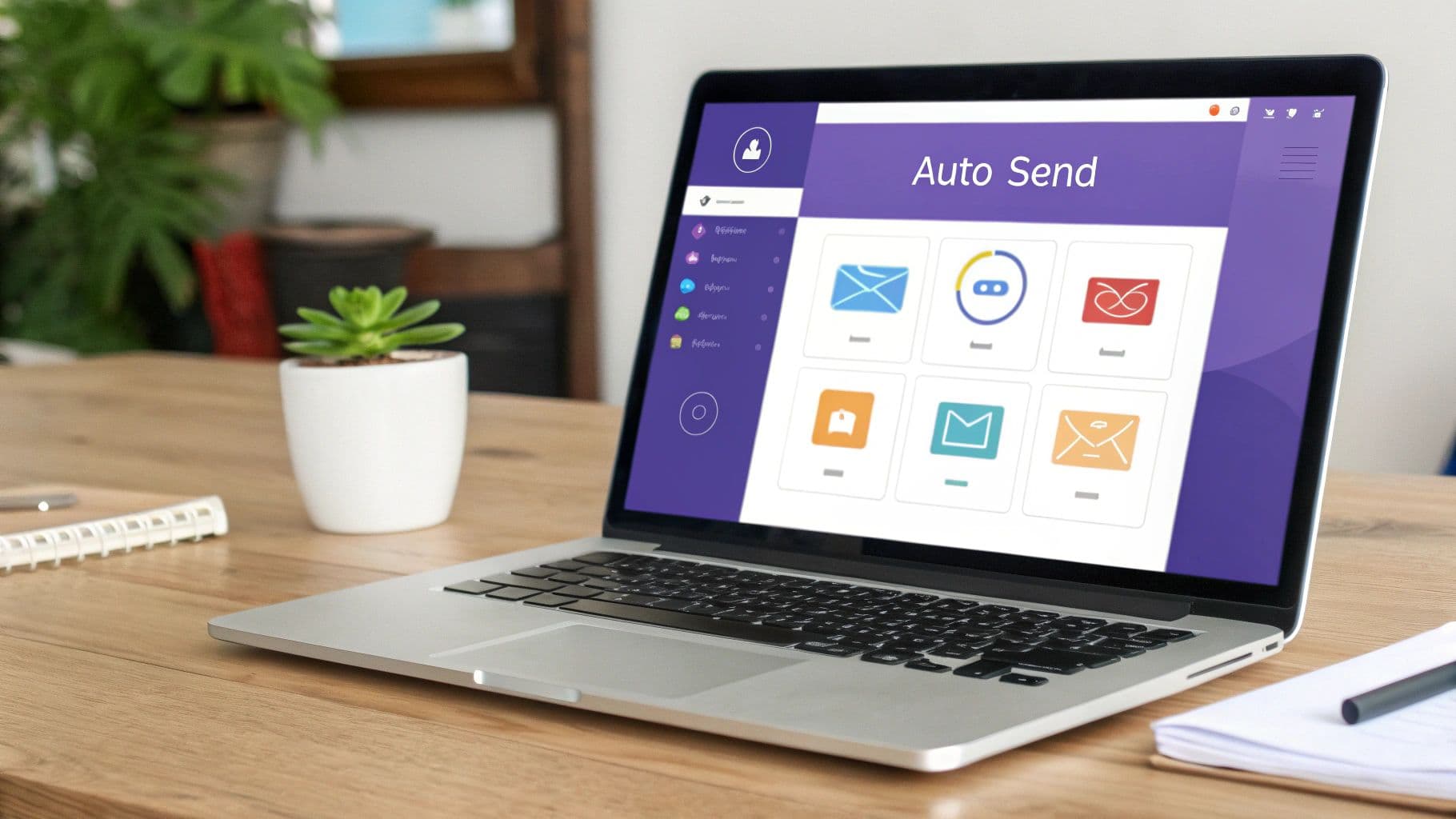Email Marketing for Affiliates That Actually Converts

When you're an affiliate, email marketing isn't just another strategy—it's your direct line to the people who trust your recommendations. It’s your most powerful tool for building a genuine relationship with your subscribers, sharing real value, and then earning commissions by promoting products you actually believe in. This gives you direct control over your business, freeing you from the whims of unpredictable social media algorithms.
Why Email Is Your Top Affiliate Asset
Let’s get straight to the point: for any serious affiliate marketer, your email list is your single most valuable asset. A huge social media following might look great on the surface, but you're effectively building your business on rented land. One algorithm tweak or a sudden policy change can completely tank your reach, essentially turning off your income faucet overnight.
An email list, on the other hand, is an audience you truly own. It's a direct, unfiltered channel to people who have explicitly said, "Yes, I want to hear from you." This is the core reason why email marketing consistently delivers a higher return than almost any other channel out there for affiliates.
Owning Your Audience vs. Renting It
This distinction between an "owned" and "rented" audience is everything for long-term success. A rented audience on platforms like Instagram or TikTok is always at the mercy of the platform's rules, organic reach limits, and ever-increasing ad costs. You’re constantly battling just to be seen.
To truly understand the strategic difference, let’s compare them side-by-side.
Owned Audience vs Rented Audience for Affiliates
| Attribute | Email List (Owned Audience) | Social Media (Rented Audience) |
|---|---|---|
| Control | Total control. You decide what, when, and how you communicate. | No control. You are subject to platform algorithms, rules, and potential suspension. |
| Reach | Direct access to every subscriber's inbox. No gatekeeper. | Throttled reach. Only a small fraction of your followers see your posts organically. |
| Relationship | Deep and personal. Perfect for long-form content and building genuine trust. | Superficial and fleeting. Built for quick consumption and short attention spans. |
| Longevity | A permanent asset. Your list grows in value over time and is portable. | Temporary. Your following can vanish if the platform loses popularity or your account is shut down. |
| ROI | Extremely high. Low cost to maintain with a direct path to monetization. | Variable and declining. Often requires ad spend to achieve meaningful reach. |
The takeaway is clear: while social media has its place for discovery and engagement, your email list is where you build a sustainable and profitable affiliate business.
"Building an email list is the single most important activity for a serious affiliate marketer. It transforms your business from a series of one-off campaigns into a sustainable, long-term asset."
The Unmatched ROI of Email
The numbers don't lie—the financial case for prioritizing email is rock solid. The efficiency and directness of email translate into some seriously powerful returns. Of course, this assumes you're following the fundamentals, which is why it's always smart to brush up on the 10 email marketing best practices.
The data is pretty staggering. Most studies show email marketing delivering an ROI between $36 and $42 for every single dollar spent. It's an indispensable tool for any affiliate looking to generate revenue efficiently.
This isn't a fluke. The entire email marketing market is exploding—growing from $7.5 billion in 2020 and projected to hit $17.9 billion by 2027. This growth is being driven by powerful automation and hyper-personalization, which are a perfect match for targeted affiliate promotions. If you want to dive deeper into the data, you can check out the full research on email marketing's powerful statistics.
Building an Email List That Wants to Buy

Let's be blunt: a huge email list filled with the wrong people is completely worthless. Your goal isn't just a large subscriber count; it's an engaged list of people genuinely interested in your niche who trust your recommendations.
To achieve this, ditch the generic "subscribe to my newsletter" plea. It won't work. Your first action step is to create a high-value lead magnet: a specific, irresistible resource you offer for free in exchange for an email address. The key is to create something that solves a real, immediate problem for your audience, which naturally attracts qualified leads instead of just freebie seekers.
Creating Lead Magnets That Attract Buyers
A great lead magnet acts as a filter. It pre-qualifies subscribers by directly addressing a pain point that the products you promote can solve down the road.
Here are some actionable lead magnet ideas that attract the right audience:
- A Curated Tools List: If you're an affiliate for project management software, create a PDF guide like "The 5 Essential (and Free) Tools for Organizing Your Remote Team." This immediately attracts people who are actively looking for solutions in that exact space.
- An Exclusive Video Tutorial: Film a short, actionable video showing how to get a specific result with a product you promote. For example: "How to Design Your First Logo in Canva in Under 10 Minutes."
- A Mini-Course via Email: Set up a 3-day or 5-day automated email course that teaches a valuable skill. If you're a photography affiliate, create a course called "5 Days to Better iPhone Photos." Each email can share a practical tip while subtly mentioning affiliate gear like a specific tripod or lens.
The best lead magnets provide a quick win. They offer an immediate solution or a piece of valuable knowledge that makes the subscriber feel they received real value right from the start, building instant trust.
Promoting Your Lead Magnet for Maximum Impact
Once you've created your lead magnet, you can't just stick a sign-up form in your website's footer and hope for the best. Your next action is to promote it strategically in high-visibility locations where potential buyers are already active.
Here's where to place your lead magnet for maximum sign-ups:
- On Your Niche Blog: Use exit-intent pop-ups on your most relevant articles. If a reader is finishing a post about "best budget web hosting," you can trigger a pop-up offering your "Ultimate Web Hosting Comparison Checklist."
- Within Your YouTube Content: Don't just rely on the description box. Verbally mention your lead magnet in your videos and direct people to the link. A simple call-to-action like, "I've put together a complete list of all the gear I use… you can download it for free at the link below," works wonders.
- In Guest Posts or Podcast Interviews: When you're featured on other platforms, mention your lead magnet as a resource for listeners who want to dive deeper into the topic.
This is a cornerstone of how to succeed in affiliate marketing—by building an audience that actually wants to hear from you. The affiliate marketing industry is exploding, with a global value projected to hit an incredible $31.7 billion by 2031. Building your own audience is no longer just a good idea; it's essential for long-term success.
A critical part of managing this audience is to build a robust customer segmentation strategy, which is just a fancy way of saying you need to send the right offers to the right people at the right time.
https://www.pushlapgrowth.com/blog/how-to-succeed-in-affiliate-marketing
Writing Affiliate Emails That Drive Clicks

Once you've built an engaged list, the real work begins. An effective affiliate email positions a product as the exact solution to a problem your subscriber is facing right now. This shifts you from being just another marketer to a trusted advisor.
The entire process hinges on that first impression: the subject line. It's your one shot to earn the open.
Crafting Subject Lines That Get Opened
A good subject line piques interest without screaming "I'm an ad!" Generic, salesy titles are the fastest way to get ignored or flagged as spam. Your subject line must spark curiosity, create urgency, or highlight a clear benefit. The secret to powerful email marketing for affiliates is making each person feel like you wrote that email specifically for them.
Here are proven subject line formulas for affiliate promotions:
- Benefit-Driven: "Finally, a way to [achieve desired outcome]" (e.g., "Finally, a way to rank on Google's first page")
- Curiosity-Focused: "My biggest mistake with [a common problem]" (e.g., "My biggest mistake with keyword research")
- Personal Story: "How I solved [my biggest challenge]" (e.g., "How I tripled my traffic in 3 months")
- Question-Based: "Are you still struggling with [pain point]?" (e.g., "Are you still struggling to get affiliate clicks?")
Instead of a bland subject like "25% Off Awesome SEO Tool," use "The one tool that finally fixed my keyword research." The first is an ad; the second is the start of a story that gets opened.
Weaving Your Link into a Compelling Story
The most common affiliate mistake is dropping a raw link into an email with a generic call to action. The highest-converting affiliate emails read like a personal recommendation from a friend.
The most effective way to do this is by wrapping your affiliate link inside a genuine story. People connect with narratives, not a boring list of product specs.
Share your own real experience with the product. What specific problem were you facing? How did this product make a difference? Walk your reader through your journey, from the initial frustration to the ultimate success.
Your personal story is your most powerful conversion tool. It provides immediate social proof and builds an emotional connection that a simple list of features never can. When you share a real-world result, your recommendation gains instant credibility.
Making the Call-to-Action Count
Your call-to-action (CTA) is the final, crucial step. It needs to be crystal clear, direct, and compelling. Vague phrases like "Click Here" don't work anymore. Use action-oriented language that specifies the value they'll get by clicking.
Try these specific CTA examples:
- "See how I used [Product Name] to triple my traffic."
- "Grab my exclusive bonus and get started today."
- "Find out if [Product Name] is the right fit for you."
Finally, be transparent. An affiliate disclosure at the bottom of your email doesn't hurt conversions—it builds trust. A simple line like, "(P.S. This email contains affiliate links. If you buy something, I might get a small commission at no extra cost to you. I only recommend stuff I genuinely use and love!)" shows you're being upfront and protects you.
Using Automation to Boost Your Commissions
Sending a manual email blast to your entire list is an outdated tactic. To scale your affiliate income, you must deliver the right offer to the right person at the right time. This is precisely where automation becomes your most powerful tool for affiliate email marketing.
Automation lets you stop shouting at everyone and start having thousands of personalized conversations at once. Instead of a generic, one-size-fits-all message, you can build automated sequences—often called workflows or funnels—that trigger based on a subscriber's actions. This makes your recommendations feel less like a sales pitch and more like helpful advice.
Segmenting Your Audience for Precision Targeting
The foundation of smart automation is segmentation. This means dividing your email list into smaller, focused groups based on their interests or behavior. When you know who you're talking to, crafting the perfect message becomes simple.
Here are actionable ways to segment your list:
- Behavior: Create a segment of subscribers who clicked your affiliate link for a specific software but didn't buy. Tag them as "Interested-[ProductName]" for a targeted follow-up campaign.
- Purchase History: If you know someone bought a beginner-level product you recommended, tag them as "Beginner-Customer." They are now a prime audience for future campaigns promoting more advanced tools.
- Stated Interests: Segment subscribers based on the lead magnet they downloaded. Someone who grabbed your "Beginner's Guide to SEO" should be tagged "Interested-SEO" and receive offers for keyword research tools.
This simple flow chart really breaks down how logical this process is.

The key insight is that segmentation isn't a complex technical task. It's the process of listening to what your audience's actions are telling you and then responding with something relevant.
Building Simple but Powerful Automation Workflows
Once your segments are in place, you can build automation workflows that run 24/7, driving commissions while you sleep. You don't need a 50-step sequence to see results.
Start with these two high-impact automations:
-
The Affiliate Welcome Series: When a new subscriber joins, create a 3-5 day automated series. Introduce yourself, deliver immediate value, and then strategically weave in your top affiliate partners. For instance, if you’re big on SaaS, you could build a welcome sequence that highlights the best https://www.pushlapgrowth.com/blog/saas-affiliate-programs you're partnered with.
-
The "Interested but Didn't Buy" Campaign: This automation is pure gold. Set up a trigger for when a subscriber clicks an affiliate link but doesn't convert. A day or two later, an automatic email can go out that handles common objections, shares a case study, or offers an exclusive bonus to nudge them toward the finish line.
The most important thing to remember is that automation isn't about being robotic—it’s about being incredibly relevant at scale. It lets you create a personalized journey for every single subscriber, which dramatically increases the chance of a conversion.
The data backs this up in a big way. Research shows that affiliate marketers who use email marketing see 66.4% more conversions than those who don't. That massive lift is almost entirely due to the power of nurturing leads through personalized automation. With nearly 22.8% of affiliates naming email their number one traffic source, it's obvious that mastering these techniques is non-negotiable for growth.
To really get your automated campaigns dialed in, I’d recommend digging into these essential marketing automation best practices. Following these principles will help you fine-tune your workflows and ensure your messages feel both personal and incredibly effective.
How to Track and Optimize for More Profit

Sending your affiliate campaign is just the beginning. The most successful affiliates treat their email marketing like a continuous science experiment. It’s all about testing, tweaking, and making small, data-backed adjustments that lead to significant gains in earnings.
To do this right, look past vanity metrics like open rates. The numbers that truly matter are the ones directly tied to your commissions: clicks and conversions.
Pinpointing Your Most Profitable Links
Your first action step for optimization is to find out which emails and links are actually driving sales. Without this insight, you’re flying blind. The best way to gain this clarity is by using UTM parameters.
UTM codes are short bits of text you add to the end of your affiliate links. They don't change the link's destination, but they pass crucial tracking information to your analytics. For email marketing for affiliates, this is a game-changer.
For example, imagine you promote a software tool in your welcome series and a weekly newsletter. By using unique UTMs for each, you can see precisely which placement drove the sign-ups.
Here’s a practical UTM structure for a welcome series email:your-affiliate-link.com/?utm_source=email&utm_medium=autoresponder&utm_campaign=welcome_series
This simple tag tells you the click came from your email autoresponder within your welcome series campaign. Suddenly, you have actionable data to inform your strategy.
By tracking conversions with UTM parameters, you stop guessing and start knowing. You can double down on what works (like a high-converting email in your welcome series) and cut or rework what doesn't.
A Framework for Continuous Improvement
With tracking in place, you can start A/B testing. This is where you create two versions of a single element—like a subject line or a CTA button—and send each to a different portion of your audience to see which one performs better.
The key rule is to test only one variable at a time. If you change the subject line and the email copy, you won't know which change made the difference.
Here are the highest-impact elements to start testing:
- Subject Lines: Test a curiosity-driven subject line ("My biggest marketing mistake…") against a benefit-focused one ("How I doubled my traffic with this tool").
- Email Copy: Test a personal, story-based approach against a more direct, feature-heavy email.
- Calls-to-Action (CTAs): Test a simple button like "Learn More" against something specific, such as "See the Tool in Action."
By systematically testing these variables, you’ll uncover the specific formulas that resonate with your audience. This is how you move from being a casual promoter to a data-savvy marketer.
The Metrics That Really Matter
To A/B test effectively, you must monitor the right numbers. Here are the key performance indicators (KPIs) that give you a clear picture of your campaign’s health.
Essential Email Metrics for Affiliate Marketers
| Metric | What It Measures | How to Improve It |
|---|---|---|
| Click-Through Rate (CTR) | The percentage of email recipients who clicked on at least one link. | Write more compelling copy, create stronger calls-to-action (CTAs), improve link placement, and ensure your offer is relevant to the segment. |
| Conversion Rate | The percentage of clickers who completed the desired action (e.g., made a purchase, signed up for a trial). | Improve the landing page experience, ensure messaging consistency between the email and the offer page, and promote higher-quality products. |
| Earnings Per Click (EPC) | The average amount of money you earn every time someone clicks your affiliate link. | Focus on promoting offers with higher commission rates or better conversion rates. Pre-qualify your audience so clicks are more likely to convert. |
| Unsubscribe Rate | The percentage of recipients who opted out of your email list after receiving the email. | Ensure content is valuable and relevant, don't email too frequently, set clear expectations when people subscribe, and clean your list regularly. |
Tracking these metrics gives you a dashboard for your affiliate promotions. A high CTR with a low conversion rate might signal a disconnect between your email's promise and the landing page's offer. A high unsubscribe rate on an email tells you the content missed the mark. This is the data that fuels profitable growth.
Common Questions on Affiliate Email Marketing
Even with a great strategy, you're bound to have questions. Here are clear, practical answers to the most common ones from affiliate marketers.
Can I Put Affiliate Links Directly in My Emails?
Yes, you can, but you must do it correctly. Most modern email platforms like ActiveCampaign or ConvertKit are fine with affiliate links, but your first step should be to read their terms of service. Do not skip this.
The golden rule is to only promote high-quality products you genuinely believe in. Your audience’s trust is your most valuable asset. Always include a clear affiliate disclosure to maintain that trust and comply with FTC guidelines.
How Often Should I Email My Affiliate List?
There’s no magic number. The ideal frequency depends on your audience and niche. For most affiliates, sending one high-value email per week is a fantastic starting point.
Consistency and value will always outperform raw frequency. A single, genuinely helpful weekly email with a well-placed offer will always do better than a daily barrage of hard-sell messages that just leads to unsubscribes.
Monitor your open rates, but pay even closer attention to your unsubscribe rates. If unsubscribes spike after an email, it's a clear signal to re-evaluate your content or frequency.
Which Email Marketing Platform Is Best for Affiliates?
The most important feature is a platform that is explicitly “affiliate friendly.” You need to know your account won't be shut down for doing business. Popular choices like ConvertKit, AWeber, and GetResponse are well-known for supporting affiliates.
When comparing options, look for these key features:
- Powerful Segmentation: Can you easily tag and group subscribers based on clicks and interests? This is critical for sending relevant offers.
- Intuitive Automations: Can you build welcome sequences and targeted follow-ups without needing a developer?
- Clear Analytics: Does the platform make it easy to track clicks and conversions so you can see what's working?
As your program grows, you’ll also start thinking about different ways to promote your partners. Understanding the key differences between affiliate marketing vs influencer marketing can help you decide which approach works best for specific campaigns or platforms.
Ready to manage and scale your affiliate program with a platform built for growth? Push Lap Growth provides all the tools you need, from a branded portal and real-time tracking to automated payouts and a curated affiliate marketplace. Start your 14-day free trial and see how easy it is to accelerate your revenue.